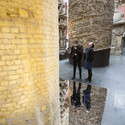The EU costs you the same as Netflix - is it worth it? Rem Koolhaas thinks so.
The Guardian: The Latest Architecture and News
Why the EU Membership is Worth it According to Rem Koolhaas and Stephan Petermann
In New York City, When Form Follows Finance the Sky's The Limit

The hyperreal renderings predicting New York City’s skyline in 2018 are coming to life as the city’s wealth physically manifests into the next generation of skyscrapers. Just like millennials and their ability to kill whole industries singlehandedly, we are still fixated on the supertalls: how tall, how expensive, how record-breaking? Obsession with this typology centers around their excessive, bourgeois nature, but – at least among architects – rarely has much regard for the processes which enable the phenomenon.
People Are Sharing this Puzzle that Supposedly Tests Whether You're "Smarter Than an Architect"

Over at The Guardian, mathematician Alex Bellos has an article series in which he asks readers to send their solutions to a weekly puzzle. That sounds innocent enough, but this week's installment might have caused architects to double-take: inspired by a reader who remembers it from his days as an architecture student, solving Monday's puzzle suggests that a reader is "smarter than an architect."
The puzzle itself looks somewhat like a child's block puzzle. Three holes—a square, circle, and triangle—are presented. But unlike a child's puzzle, in which you'd normally have square, circular and triangular blocks that fit the holes, the challenge here is to visualize a single block which would fit perfectly through all three holes.
11 Architecture, Design and Urbanism Podcasts to Start Listening to Now

It can sometimes feel as if the world is divided into two camps: those who do not listen to podcasts (probably because they don’t know what a podcast is) and those who listen to podcasts, love podcasts, and keep badgering their friends for recommendations so they can start listening to even more.
Unlike other media, it’s notoriously difficult to discover and share podcasts – even more so if you’re looking for a podcast on a niche subject like architecture, design or urbanism. To help you in your hour of need, Metropolis’ Vanessa Quirk (author of Guide to Podcasting) and ArchDaily’s James Taylor-Foster (whose silvery tones you may have heard on various architecture and design audio stories) have come together to compile this list of eleven podcasts you should subscribe to.
Have We Reached the End of the Iconic Image?

In October 1997, the unforgettable swooping metal panels of Frank Gehry’s Guggenheim Bilbao made their debut, drawing the attention of art and architecture lovers around the world. Images of the building quickly circulated through the infant world wide web, turning the museum into an instant icon that permanently elevated and transformed the international perception of the city of Bilbao.
Cities all over the world saw the potential in creating their own “Bilbao Effect,” and soon, a slew of new eye-catching, sculptural buildings had be built. This phenomenon persisted through the 2000s, manifesting itself in works by Gehry, Zaha Hadid, and many others. But recently, notable figures both inside and outside architecture have began to distance themselves from the icon, notably in the design philosophies of OMA and alumni such as Jeanne Gang and Matthias Sauerbruch.
In a new opinion piece for the Guardian, photographer Stuart Franklin extends this sentiment not just to architecture, but to all images in general. Franklin explains the history of the “iconic image” and the reasons why it may no longer exist.
Read Franklin’s full piece, here.
Heathrow Illustrations Envision the Future of Sustainable Airports
Alongside designer Paul Tinker and developer Esteban Almiron, UK-based illustrator Sam Chivers has created a series of animations visualizing the sustainable development of airports for a recent Guardian piece. The animations, which describe the topics of transport, alternative energy, noise reduction, airport terminal design, biodiversity, and fuel efficiency, capture the passage of time from morning to evening in Heathrow Airport in London.
5468796 Architecture's Response to The Guardian Over their "Failed" Social Housing Project

Early this month, The Guardian published a widely shared and debated article titled "Crime in the community: when 'designer' social housing goes wrong." The article told the story of Centre Village, a social housing project in Winnipeg designed by 5468796 Architecture and Cohlmeyer Architecture Limited, examining how noble intentions resulted in what they describe as "apartments poorly suited to family life, and a building structure that seems to act as a magnet for drinking and drug-taking at all hours."
Unsurprisingly 5468796 Architecture, who disagreed with much of the article's conclusions, wrote a response to the editor of Guardian Cities in the hope that their "letter to the editor" would provide some balance to the story. After The Guardian declined to publish the letter, the firm reached out to ArchDaily to ensure that their side of the debate was heard. Here is that letter in full.
We are writing to you in response to the Guardian article concerning Centre Village and many of the comments and re-posts over the last week. We believe the story that was published was inaccurate and provide the following for your information:
Playing the Housing Game for Profit: the British Volume Housebuilding Project

In his essay "Figures, Doors and Passages", the architectural historian Robin Evans described how "it is difficult to see in the conventional layout of a contemporary house anything but the crystallization of cold reason. Because of this," he asserted, "we are easily led into thinking that a commodity so transparently unexceptional must have been wrought directly from the stuff of basic human needs." His words, which highlight the passive approach of designers, developers and dwellers when it comes to the vast majority of British housing being built today, were first published in 1978 – two years before the Conservative government under Margaret Thatcher introduced the 1980 Housing Act.
When "Designer" Social Housing Goes Wrong: The Failures of Winnipeg's Center Village Project

The challenges of designing social housing are complex. As Martha Thorne recently told the Guardian, "It’s not enough to make community space and say, ‘People are going to see each other’... Architects really have to understand the context from the client – the cultural context, to the bigger context, to the economics, to the future of the residents who’ll live there.” Speaking about Winnipeg's well intentioned Centre Village project designed by 5468796 Architecture, Thorne believes many of these challenges are new to architects.
Just five years old, Center Village was designed as a community-oriented micro village for 25 families in one of Canada's poorest urban areas. Since its establishment, the complex has become a hot bed for crime; courtyards are being used by vagrants as shelter from police, while large families try to make a life within the cramp quarters of each home.
Oliver Wainwright on London's "Tortured Heap of Towers"

The Guardian's latest, Oliver Wainwright and Monica Ulmanu discuss London's controversial skyline and the forces that shape it. "Perhaps the tortured heap of towers that seem to be the future of London’s skyline (some thrilling, some monstrous, all very large) is inevitable," says Wainwright. "It is a vertical expression of the Square Mile’s medieval street pattern, forced skywards by global finance and massaged by reactive planning – the chaotic cocktail of invisible forces shaping the city." Read the whole article, here.
Is Edinburgh's UNESCO World Heritage Status Under Threat?

"A spectre," writes Kevin McKenna for The Guardian, "thought happily to have been exorcised from the heart of beautiful Edinburgh, is stalking the city’s old wynds and crevices once more." To put it more bluntly, the "formal recognition of [the Scottish capital] as one of the world’s most beautiful cities is under threat, amid a battle for the soul of its most historic quarter." As the UNESCO inspectorate moves in to determine whether the city's World Heritage Status should be renewed McKenna laments, through a series of case studies, the potentially bleak built future of one of Britain's most loved urban centres.
Critics Take On "The State of the Art of Architecture" in Chicago

Last week, the Chicago Architecture Biennial opened to over 31,000 visitors and much fanfare, and for good reason - it is the largest architecture event on the continent since the 1893 World's Columbian Exposition, featuring over one hundred exhibitors from over thirty countries. With a theme as ambiguous as "The State of the Art of Architecture," and with the hope of making the biennial, according to directors Joseph Grima and Sarah Herda, "a space for debate, dialog and the production of new ideas," the event was sure to generate equally wide-ranging opinions. Read on to find out what the critics had to say about the Biennial.
Challenging the Rules of a City Simulator in Which There is No "Game Over"

As part of an ongoing series of articles for Guardian Cities, architect Finn Williams uses the Cities: Skyline Simulator to ask whether "the game’s growth-driven model proves incompatible with a post-growth strategy" — ultimately narrating its response to this challenge in the form of a "resounding no." The game, which is designed to "realise the thrill and hardships of creating and maintaining a real city," allows for players to deal with infrastructure issues, housing problems, and budgetary matters on a large urban scale.
Alain de Botton: "London is Becoming a Bad Version of Dubai"
"London is on the verge of being ruined for all future generations," says Alain de Botton – a Swiss philosopher, notable author and founder of The School of Life and Living Architecture. "With a whopping 260 towers in the pipeline no area is safe, as planners, property developers and the mayor's office commit crimes against beauty to create fun buildings." In a film for The Guardian De Botton explains why he believes we're right to be nervous – and how we can stop this "clear desecration" of the UK's capital city.
How Popular Could "Anti-Builder" and "Anti-Architect" Homes Become?
The UK is in the midst of a housing crisis, the intricacies of which were detailed by Rowan Moore earlier this year. For decades the typical British housing stock has been of relatively poor quality, proliferated by developer-led consortiums and characterised by ruthless cost-efficiency for maximum profit. From this formula comes nothing but a monotony of off-the-shelf constructions which have, over time, become a national benchmark. These houses – often built of brick, boxy in form, and using as little space in the facade for openings – are commonly dark, spatially inadequate, and far below the standards that should be being aimed for. It’s like living in a well-appointed cave.
Grayson Perry On 'A House For Essex' And His Collaboration With FAT

In an article for The Guardian, Turner Prize winning ceramic artist Grayson Perry has written for the first time about his "plans for a Taj Mahal in Essex." The designs for the House for Essex, which have been realised over the last three years by FAT and led by Charles Holland, are of a "secular chapel" in the heart of the southern English countryside. The building was commissioned by the Living Architecture Project, which is headed by Alain de Botton and are the proprietors of property designed by the likes of Peter Zumthor, MVRDV, and David Kohn. This, their fifth foray into experimental collaborative architecture between architects and artists, is set to open its doors for holiday letting this year.
Review: 'All Of This Belongs To You' - Civic Urbanism At London's Victoria & Albert Museum

The Victoria and Albert Museum (V&A), named after the Queen and Her Consort, has its foundations in the Great Exhibition of 1851 amidst the wealth, innovation and squalor of the Industrial Revolution. Britain was flooded by prosperity which allowed for the development of major new institutions to collect and exhibit objects of cultural significance or artistic value. The institute’s first director, Henry Cole, declared that it should be “a schoolroom for everyone,” and a democratic approach to its relationship with public life has remained the cornerstone of the V&A. Not only has it always been free of charge but it was also the first to open late hours (made possible by gas lighting), allowing a more comprehensive demographic of visitor.
Their latest exhibition, which opens today, seeks to realign the museum’s vast collection and palatial exhibition spaces in South Kensington with these founding concepts. The interventions of All of This Belongs to You attempt to push the V&A’s position as an extension of London’s civic and cultural built environment to the fore, testing the museum’s ability to act as a 21st century public institution. To do this in London, a city where the notion of public and private is increasingly blurred, has resulted in a sequence of compelling installations which are tied together through their relevance either in subject matter, technique, or topicality.
The Urbanist's Guide to the World

A compilation of all posts in the "Urbanist's Guide to..." series from Guardian Cities, "The Urbanist's Guide to the World" takes readers to cities across the globe. Penned by local bloggers in cities from Manila to Sao Paulo, Tehran to New Orleans, the vignettes are supported by The Rockefeller Foundation and cover everything from "best" and "worst buildings" to cleanliness, soundscapes, and "the best place for a conversation." You can view the interactive guide here.
















